This week’s Fact-check (it’s late, I know, sorry!) looks at another controversial skincare ingredient, hydroquinone. What is hydroquinone, what benefits does it have in skincare, why do people say it’s harmful, and is it actually bad? Let’s find out…
What is hydroquinone?
Hydroquinone (sometimes referred to as “HQ”) is a chemical with the structure shown below:
It occurs naturally in small quantities in things like fruits, beer, coffee, and various animal products too.
What does hydroquinone do?
Hydroquinone is the gold standard for getting rid of uneven dark pigment patches in the skin (hyperpigmentation), which are areas with more melanin pigment than normal. Many different conditions can cause these pigment patches, including hormone-related melasma, trauma-induced post-inflammatory hyperpigmentation (PIH – such as dark marks left over from acne) and sun damage (usually from UV rays).
The main way hydroquinone fades pigment patches is by slowing down melanin production by cells called melanocytes in the skin. The first step in the formation of melanin involves the transformation of the amino acids tyrosine and L-DOPA into dopaquinone, performed by an enzyme called tyrosinase.
Since hydroquinone is shaped a bit like tyrosine and L-DOPA, having it around means the tyrosinase will accidentally grab a hold of the hydroquinone instead of the tyrosine. As a result, there’s less tyrosinase available for transforming tyrosine and L-DOPA, so melanin is made more slowly.
It’s kind of like if someone keeps cramming balls of paper in your mouth, it’ll take ages to eat your lunch! (This may be the focus of my upcoming blockbuster diet book, keep an eye out.)
Concentrations of 2-4% hydroquinone in a topical cream (that’s cream you rub on your skin) are effective at reducing hyperpigmentation. Hydroquinone is also a potent antioxidant, which can soak up free radicals which can cause more pigment to form.
Related post: My Routine for Fading Acne Marks (Post-Inflammatory Hyperpigmentation)
Why are people making a fuss about hydroquinone?
Due to some concerns about safety, hydroquinone is now prescription-only in many countries such as those in the EU, and the FDA has been considering a similar restriction in the US. Its use is also strictly controlled in many African and Asian countries.
Is hydroquinone safe?
There are a number of issues that are concerning with the use of hydroquinone on your skin, and they range from scary to not-so-scary:
Carcinogenic activity
Several studies on rats reported that rats that were fed or injected with large amounts of hydroquinone were found to have more tumours. This led the FDA to suggest banning hydroquinone altogether.
However, there’s been no link found between hydroquinone and cancer in humans, despite many years of use. That’s one of the problems with making conclusions about harmful effects in humans on the basis of animal studies – human and animal biology is quite different. In this case, hydroquinone is processed by human livers and rat livers very differently.
It’s also worth noting that a lot of food items contain hydroquinone, including coffee (0.31 micrograms per gram), wheat germ (10.65 micrograms per gram) and pears (D’Anjou pears have 15.09 micrograms per gram).
Ochronosis
A very rare side effect of hydroquinone is ochronosis, a condition where even darker hyperpigmentation develops. It’s more commonly in develops in people with darker skin.
However, ochronosis usually only happens when there’s prolonged use of hydroquinone, or the use of high concentrations. Some cases of ochronosis are also possibly not from the hydroquinone at all, but are actually caused by other, more dangerous, illegal skin bleaching ingredients in the treatments, such as mercury compounds and glucocorticoids.
There are very few cases of ochronosis reported from hydroquinone treatments in countries where hydroquinone is well regulated.
Skin sensitivity
Hydroquinone can be harsh on skin. A significant proportion of people are allergic to it, and in a lot of other people it can cause irritant contact dermatitis, where your skin gets itchy and red. If it’s too irritating, you might need to use a steroid cream in conjunction with the hydroquinone treatment.
During and after hydroquinone treatment, your skin also becomes more vulnerable to UV rays. This means extra sun protection measures are needed to prevent skin damage, skin cancer or rebound hyperpigmentation. A high protection sunscreen is a must!
Destruction of melanocytes
One issue with hydroquinone doesn’t really come from hydroquinone itself. It’s the fact that, once you’ve opened a tube, the hydroquinone slowly reacts with oxygen in the air to form chemicals like p-benzoquinone and hydroxybenzoquinone. These chemicals can kill melanocytes, the cells that make melanin.
Unlike the action of hydroquinone itself, these new substances actually leads to skin bleaching, which is often uneven and patchy. You can avoid this side effect by throwing away the cream if it becomes discoloured (hydroquinone creams slowly turn yellow-brown over time), and by using products that come in air-tight packaging.
Are there alternatives to hydroquinone?
There are quite a few pigment-lightening alternatives to hydroquinone on the market now – I’ve written about them in this post: What are the skin lightening alternatives to hydroquinone? These alternatives include retinoids, azelaic acid, arbutin, kojic acid, licorice extract, vitamin C and N-acetyl glucosamine.
A few of these ingredients also work to enhance the action of hydroquinone, which means you can use less of it (reducing potential side effects) and still get excellent results. For example, Tri-Luma Cream contains 4% hydroquinone, along with 0.05% tretinoin which increases skin cell turnover rate so melanin is shed faster, and 0.01% fluocinolone acetonide, a mild corticosteroid that reduces any inflammation from the treatment.
Bottom line
Hydroquinone is not as scary as you might think, from all the fuss about it! It’s the best pigmentation-reducing ingredient on the market.
However, there are still some possible side effects like irritation, which can be reduced by using hydroquinone in smaller quantities, in conjunction with other products. There are also safer alternatives available, even though they’re less effective.
References
ZD Draelos, Skin lightening preparations and the hydroquinone controversy, Dermatologic Therapy 2007, 20, 308.
TS Poet, H Wu, JC English and RA Corley, Metabolic rate constants for hydroquinone in F344 rat and human liver isolated hepatocytes: application to a PBPK model, Toxicol Sci 2004, 82, 9.
CB Lynde, JN Kraft and CW Lynde, Topical treatments for melasma and postinflammatory hyperpigmentation, Skin Therapy Letter, 2006, 11, 1.
J Levitt, The safety of hydroquinone: a dermatologist’s response to the 2006 Federal Register, J Am Acad Dermatol 2007, 57, 854-872.

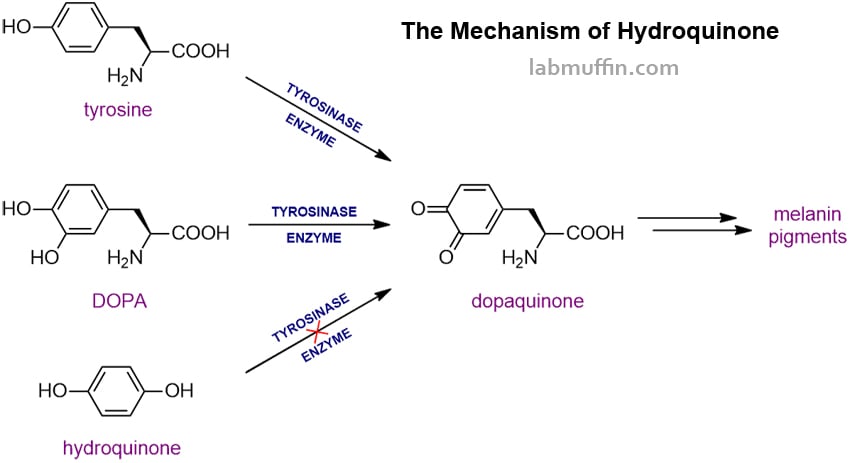


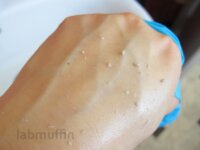
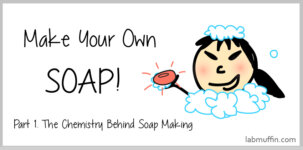
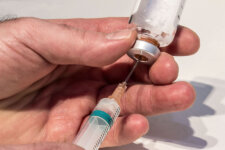
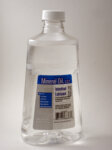
I have some hydroquinone cream (it’s available OTC in pharmacies here in NZ) that I bought to fade some post-acne hyperpigmentation, but have been too scared/too much of a product hussy to bother using it. There is a weird scab thing on my arm though that I should really try it out on. Interesting what you said about certain ingredients that potentiate the action of hydrouinone too — will look into that. Thanks for the writeup!
No worries, good luck – when in doubt, patch test!
Hello,
I think “caution” is the attitude that I tend to adopt about certain compounds such as HQ.
Check also this post from Colin:
http://colinsbeautypages.co.uk/hydroquinone-risks/
Have a nice day. 🙂
It’s one of those seemingly unavoidable things about pharmacology – the more effective something is, the more likely there’ll be severe side effects! Fixing hyperpigmentation is one of those things where there’s no perfect answer yet.
Thanks for the thoughtful and well-written article. Hydroquinone’s kind of the gold standard for hyperpigmentation treatment right now due to how effective it is, but like you mentioned, a lot of the “best drugs” come with scary side effects. That’s just the compromise that people have to make in using it. Of course, it’s best to try and treat conditions like acne and prevent sun damage before scarring/pigmentation occurs in the first place.
Totally agree – prevention is ALWAYS better than cure! But less motivating 😛
Hey LabMuffin!
I’m just a little unsure about how to use a 2% hydroquinone product I recently purchased from Paula’s Choice (the one combined with salicylic acid). I have discolouration from previous acne spots in the “triangle” region of my face, but not necessarily extending to the perimeters of my face. Is it ok to use the product all over the skin, or is it better as more of a spot treatment? Thannnks!!!
Hey, I’ve been using 4% hydroquinone for last couple of weeks. I first tried it all over my face for first couple of days but then I changed it to just the areas I have the hyperpigmentation. I had the pattern w dark patch in middle forehead and both my cheeks w dark patches. Therefore, I chose to just use it in these areas only. It’s def. working and I haven’t had any weird side effects. Thank Goodness! I’ve read reviews on 2% where some saw results and others did not. So good luck!
Hello,
I am exactly the same as you, as my melasma is in those same areas. I am currently using Tri-luma on those areas and it is working and I’m 3 weeks into this. I’m tan olive skin tone and I’m so worried about what will happen after I stop the tri-luma in a few months. I’ve heard about bounce back pigmentation that is worse after. If the pigment comes back the same, oh well, I can live with that, I just don’ t want it worse. I’m wondering if I can stop it coming back too much or worse if I am more diligent with sunscreen and apply later in the day, hats, etc. and start using a bunch of tyrosinase inhibitors to slow down the melanin. How did it go when you went off the hydroquinone?
Thank you for any info you have!
Hello Michelle
I love reading your blog, it’s so informative and educational on each posting! I recently got a bottle of Alpha Arbutin serum from The Ordinary 3 weeks ago trying to correct the dark spots, acne scars and uneven skin tone. I’ve heard hydroquinone is bad, so I did some research and found the “Alpha Arbutin” eventually turns into hydroquinone when it gets into the skin but I’ve heard it’s more gentle and safer to use and hope it will fix my problem.
I’ve been using it day and night with lots of sunscreens (75 SPF) during the day and I’ve noticed the color of my face skin is actually turned a little darker (like I had a little tan). it’s not red, not irritated, no peeling, all normal, but just looks darker than before. I’ve been using it or 3 weeks now, is it normal? or am I one of those unlucky one that can’t use anything hydroquinone because it turns my skin a shade darker instead brighten and even out my skin?
Look forward to hearing your advice.
Thanks
Alan (^__^)
Hi Michelle, my derm recommended diluting a prescription only 4% hydroquinone cream with any moisturizer and apply it to my skin for my dark under eye circles. After reading your article it seems like this is not a good idea (it may oxidize, etc.). What are you thoughts on this?